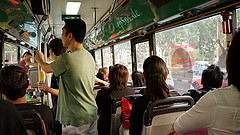8 Travel Safety Tips for Public Transportation
17 May 2012Using the public transportation system can be a great way for a traveler to save money and ‘live like a local’, but it also presents some risk.
Before enjoying the public transportation in a foreign city or country, take a moment to consider these important travel safety tips.
1. Look for an official badge or permit
A legitimate taxi driver or bus driver will have a badge displayed, so take a quick look around before you get in and feel free not to get in if you don’t see one. When you do spot a badge, check out the picture and be sure it looks like your driver.
In the U.S. taxi drivers display their permits, but you might have trouble figuring out how to tell whether a taxi or bus is official in a foreign country.
Ask the concierge at your hotel or a local police officer whether the local taxi and bus companies require employees to display badges. They can tell you what to look for.
2. Take note of logos and colors
Take note of the logos and colors of local taxis and buses even if you don’t need one immediately. This will help you spot the ones that are legitimate and those that are fake later. Fake cabs have been used by criminals to part you from your money in several ways. In some regions, fake cabs are used to kidnap tourists.
Know which are the legitimate taxis and buses to avoid getting taken for a dangerous ride.
3. Stay awake and alert at all times
You may be tempted to read a book, check your messages, or take a quick nap on public transportation, but that’s the perfect way to have your wallet, camera, backpack and other stuff stolen. Plus, you could end up in a strange place at the end of the bus line with no way to get back if you sleep too long!
Stay awake and alert no matter how tired you are. This is true when you’re in a taxi as well – your driver could be just as dangerous as a common criminal.
4. Keep close control over your bags and packages
Just like at the airport, it’s essential to keep close control over your bags and packages if you are to keep them in your possession. This is especially important if you have several bags or packages, or if everyone on the bus or train has similar bags. It’s easy for a thief to switch out an empty one that looks just like yours when all the bags come from the same retailer.
Bunch your bags between your feet or close on the seat beside you when you’re sitting, and keep hold of them when you’re standing.
5. Know where you are going
It’s an easy trap to fall into: you tell the driver where you are going and he or she takes you there, but the driver isn’t responsible for you and could even have their own malicious agenda in mind.
Knowing where you are going by having a map and paying attention to the route will help you protect yourself.
6. Get off the bus if it gets too crowded
When people are pressing in all around you, it’s harder for you to watch and protect your belongings. Crowds are not a traveler’s friend – in fact, they can make it far easier for pickpockets and thieves to do their dirty work and escape quickly.
If things are getting too crowded, get off the bus at the next well-lit stop and wait for a less crowded one.
7. Be wary of sharing
Sharing a cab is a common way to save a little money, but sharing a cab with a stranger can leave you in a bad spot. It’s a common scam in some places: you share a cab with a person who leaves behind a little contraband. Soon after, a fake cop stops your taxi and the stuff is discovered. You may be searched, arrested, robbed or even taken to a fake police station where your identification is swiped and sold over the Internet.
Sharing a cab is fine with friend, but not with strangers, no matter how kind they are.
8. Know how to call for emergency help
Sure, we all know to call 911 in America, but every country has an local emergency number that’s different. Knowing the number to dial can make the difference. If your guidebook doesn’t have it, ask the receptionist at any hotel.
See also
Damian Tysdal is the founder of CoverTrip, and is a licensed agent for travel insurance (MA 1883287). He believes travel insurance should be easier to understand, and started the first travel insurance blog in 2006.

